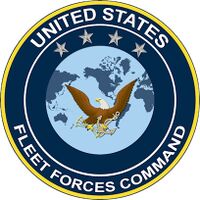OtherUS Commander US Fleet Forces Command
Cachets should be listed in chronological order based on earliest known usage. Use the postmark date or best guess. This applies to add-on cachets as well.
HISTORICAL NOTE
Commander, U.S. Fleet Forces Command (COMUSFLTFORCOM) has a long, distinguished history of service to our country and the U.S. Navy. The command was originally established as Commander-in-Chief, U.S. Atlantic Fleet (CINCLANTFLT) on 1 January 1906, by combining the Navy's North Atlantic and South Atlantic Squadrons. History indicates a continuous use of the title Commander-in-Chief, U.S. Atlantic Fleet from 1906 until 1923, and then again from 1941 to 2002. In a reorganization of the U.S. Fleet in 1923, the title was abolished and the title Commander, Scouting Force, was used.
On Feb. 1, 1941, General Order No. 143: Organization of the Naval Forces of the United States, re-established the title and reorganized the U.S. Fleet into three separate fleets — Atlantic, Pacific and Asiatic. The order further stated that each fleet would be under the command of a four-star admiral. Rear Adm. Ernest J. King, in his flagship USS Texas BB 35 at Culebra, Puerto Rico, hauled down his two-star flag and hoisted a four-star flag as commander-in-chief, U.S. Atlantic Fleet. From April 1941 to April 1948, four flagships served as headquarters for the fleet commander-in-chief: USS Augusta CA 31 (April 1941 to January 1942); USS Constellation (January 1942 to August 1942); USS Vixen PG 53 (August 1942 to May 1946) and USS Pocono AGC-16 (May 1946 to April 1948). On 5 April 1948, Atlantic Fleet headquarters moved ashore into spaces of the former US Navy hospital in Norfolk. In 2011, the staff moved across the street to a new three-story, 46,000 square-foot headquarters building.
In October 2006, a ceremony was held to officially mark the transition of U.S. Atlantic Fleet and CFFC to U.S. Fleet Forces Command. The ceremony was held aboard aircraft carrier USS Theodore Roosevelt CVN 71. The command is now known henceforth as Commander, U.S. Fleet Forces Command.
| Thumbnail Link To Cachet Close-Up Image | Thumbnail Link To Full Cover Front Image | Thumbnail Link To Postmark or Back Image | Postmark Date Postmark Type Killer Bar Text Ship --------- Category |
|---|
|
N/A |
 |
N/A |
2006 |
|
Unit Insignia |
The official emblem of the Commander of the United States Fleet Forces Command. The bald eagle represents the Fleet, ever vigilant, able to dominate its environment, and, when necessary, be decisively lethal. The four arrows, clutched securely within the eagle's talons represent the Fleet’s striking power and its ability to provide credible combat power anywhere in the world’s four oceans. The four stars represent the authority of the Commander and are silver in color to indicate the Joint nature of the Command's mission and the Joint warfighting capability of the Fleet. The fouled anchor is symbolic of naval heritage and of the strong bond between the past, present, and future generations of Navy leaders. It also recognizes that the combat readiness of the Fleet is anchored in a shore infrastructure that is well organized, manned by professionals, and efficient in execution.
|
N/A |
 |
N/A |
2021-12-07 |
|
Change of Command |
Cachet by Neal J. Mills
If you have images to add to this page, then either contact the Curator or edit this page yourself and add them. See Editing Cachet Maker Pages for detailed information on editing this page.
Copyright 2025 Naval Cover Museum